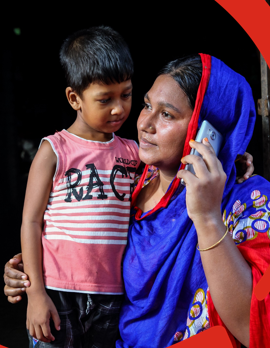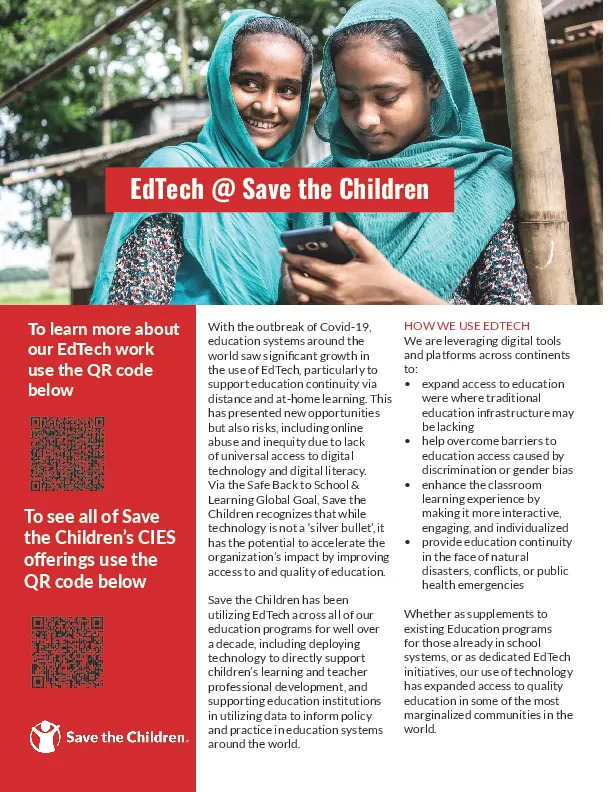Serving Up Bite-Size Mobile Learning in Sponsorship Programs
Share:
By: Ian, McClelland, Sponsorship Innovation Lead, Save the Children The US withdrawal and Taliban takeover of Afghanistan, the outbreak of civil war in Myanmar and the worldwide COVID-19 pandemic have each caused upheaval in Save the Children’s efforts to ensure all children survive, learn, and are protected from violence. But they have also been drivers of innovation. Children’s access to education and caregivers’ access to support have been severely impeded prompting organizations to rapidly adapt to a changing context.
Photo: Katharina Glynne, Save the Children Australia, 2018
Restricted ability to provide in-person support has resulted in proliferation of the use of mobile communications for “bite-size” learning and advice, also known as “microlearning”. With schools closing and more children stuck at home, it has been necessary to find new ways to support early childhood development and early-years education. While early interactive audio instruction initiatives in Sponsorship programs, such as Malawi’s “IAI Radio” project, date back at least to the late 2000s, increased mobile phone coverage in recent years has created new opportunities to support home learning, along with teacher professional development.
In recent years several Sponsorship programs have been using mobile communications to provide guidance to parents and caregivers for improved home learning environments, funded by the Sponsorship Learning and Innovation Fund . This support is delivered through two main channels: SMS messages and Interactive Voice Response (IVR). SMS messages are used to share tips and advice in written form. IVR is an automated system which allows the user to navigate through packages of audio content known as “trees”, using voice or the keypad.
Three learnings have emerged from Save the Children’s experiences. If you’re planning to provide guidance and advice using mobile communications, here’s what you might want to know…
Don’t underestimate access requirements.
Different projects have faced similar challenges in ensuring that their initiatives suited the digital environment. In Myanmar, ongoing conflict led to the closure of schools and early childhood care and development (ECCD) centres and resulted in many villages becoming inaccessible due to the risks associated with travel. In response to these challenges, the Country Office team at Save the Children used IVR to provide parenting support in eight villages. But accessibility issues arose due to network access in remote locations.
In Vietnam, the program team developed “Bonding Messages”, an accessible, low-cost, and interactive advisory service to help caregivers create positive home learning environments, in response to an earlier failure of a “Digital Carers Club” app. The app-based approached failed because it was too slow to download content and inconvenient for users. The team concluded that a comprehensive digital context assessment is vital to ensure target groups have adequate internet access and suitable digital devices for the nature of the project.

mBoost: Improving literacy and numeracy: Learning from rural Bangladesh
2021 · mEducation Alliance
This PowerPoint Presentation was delivered at the 2021 mEducation Alliance Symposium on Save the Children Bangladesh’s updates to the mBoost approach during the COVID-19... View Full Abstract
Don’t underestimate content development requirements.
Content development can itself prove challenging. In Afghanistan, “Sensitizing Parents through Messaging” was developed and delivered in partnership with Viamo, a mobile social enterprise. Three sets of messages were recorded and disseminated through an IVR hotline, focused on positive parenting techniques, early stimulation for children aged 0-3, and interactive learning and play. The messages placed strong emphasis on shared parental responsibility and involvement of fathers.
In total, 30 key messages were developed and recorded in the form of conversations between children and parents, ensuring they were engaging and easy to understand for all parents, including those with low literacy. But the challenge of creating appropriate bite-size content was greater than anticipated, and took longer, requiring an extension to the project. A particular challenge was addressing social norms which discouraged learning through play.
In Vietnam, “Bonding Messages” is a collaboration with Zalo, an easy-to-use and popular messaging platform, the Department of Education and Training, who review all materials, and 59 preschools and 44 primary schools in Lao Cai province, who facilitate groups and send the messages to parents. With such a breadth of partners, stakeholders, and users, the Country Office team quickly realized the importance of ensuring diversity of content, relevance to the education curriculum, and ease-of-understanding for a diversity of users. In Myanmar, it was necessary to translate and record a total of 25 content “trees” in three languages, including Burmese and two local languages.

Displaced Children and Emerging Technologies: Save the Children’s opportunities for investment and impact
2019 · Save the Children Denmark
Amongst the rising population of globally displaced – 68.6 million people in 2017 – the majority, 36 million, are children – almost twice the number we witnessed in 2005.This... View Full Abstract
Don’t underestimate the benefits of participation.
Lastly, encouraging greater interaction and participation is critical to success. This starts with the design of the project, when involving parents in content development and ensuring they opt-in to receiving information supports relevance, usefulness, and ongoing engagement. In Myanmar, messages were scheduled on a roughly bi-weekly basis and accessed without any cost to the recipient, but inadequate orientation was thought to have significantly hindered participation.
Once the project is underway, we learned that continued interaction is equally important. In Afghanistan, one-way messaging meant users could not share feedback, which was viewed as a significant limitation. In Myanmar, monitoring data showed only around 20% of caregivers actively listened, highlighting the need for better content and engagement strategies. In contrast, the team in Vietnam pursued a successful strategy of training facilitators to actively support digital engagement as part of the “Bonding Messages” project.

EdTech @ Save the Children
2024 · Save the Children
This material is an overview of of Save the Children’s global EdTech approach.
Our Next Steps
Across Save the Children we’re working to improve the way we use mobile communications to support teachers and families. In April 2024, the Digital Enablers launched new guidance and resources on standard messaging tools (available to Save the Children staff members) with an initial focus on bite-size learning using SMS messaging, WhatsApp, and IVR. The support package, included in the Digital Programming Guide, features tips on creating content, along with advice on budgeting, training, measurement and more.
Do you want to learn more about mobile communications and how it can better support teachers and families? You will find everything you need in the Child Rights Resource Centre.
Share
Link
